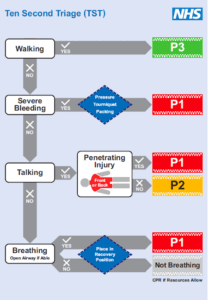Providing care should not put zero responders in increased danger. They should be advised to remain alert to current hazards and monitor for changes.
Fire control personnel should advise zero responders to give first aid only:
- If they are not injured themselves
- If the casualty cannot help themselves
- To one casualty at a time
Assessment of casualties
Fire control personnel should ask basic assessment questions to help identify casualties most in need of initial lifesaving intervention, such as those who are losing a lot of blood or are not breathing.
Questions based on the Ten Second Triage tool are likely to help fire control personnel to support zero responders to identify these casualties quickly:
Ten Second Triage
- Is the casualty able to walk?
- Yes – Casualties with minor injuries, who are in shock or confused should be told to move to a safe place
- No – Ask next question
- Are there signs of severe bleeding?
- Yes – provide initial advice to control severe bleeding. More information can be found in Control measure – Initial advice to save lives: Control severe bleeding
- No – Ask next question
- Is the casualty talking?
- Yes – Do they have a penetrating injury to the front or back of their torso, such as a stab wound?
- Yes – provide initial advice to control severe bleeding. More information can be found in Control measure – Initial advice to save lives: Control severe bleeding
- No – The casualty should be moved onto their side with their head tilted back to open their airway (recovery position)
- No – Ask next question
- Is the casualty breathing?
- Yes – The casualty should be moved onto their side with their head tilted back (recovery position)
- No – Zero responder should start cardiopulmonary resuscitation (CPR) immediately. More information can be found in Control measure – Initial advice to save lives: Unresponsive casualties.

Figure: National Ambulance Resilience Unit (NARU) Ten Second Triage tool
